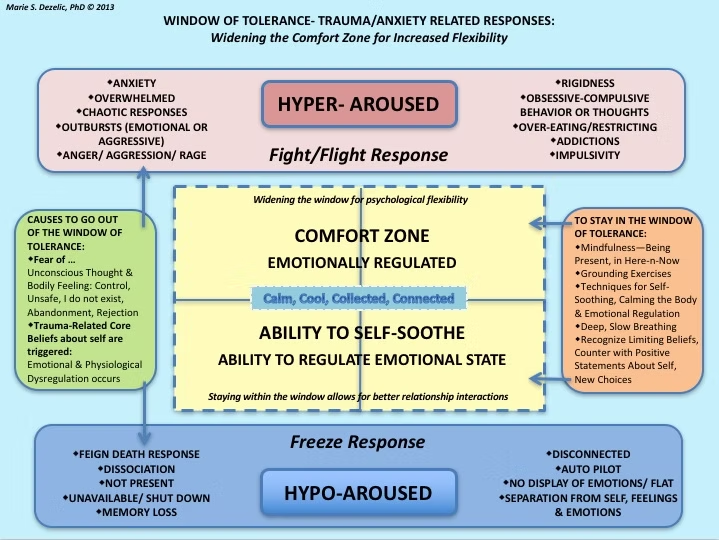Founder of Sensorimotor Psychotherapy, Pat Ogden explains trauma as any experience stressful enough to leave a person feeling helpless, frightened, overwhelmed, or profoundly unsafe—thus unable to integrate the experience (Ogden & Fisher, 2015). Trauma can be a single incident, such as a natural disaster, or it can be repeated over time, such as childhood abuse. When trauma occurs with a primary caregiver (attachment figure), the effects can be particularly difficult to resolve (Ogden & Fisher, 2015).
Integrative trauma therapist Linda Thai notes that trauma is, at its core, inescapability—being trapped in a profoundly distressing experience without the ability to take action or escape. In cases like natural disasters, this may be due to physical danger. In childhood abuse, children may be unable to leave because they are dependent on their caregiver.
The window of tolerance describes the range of nervous system arousal in which a person can function and feel regulated, especially after experiencing distressing events such as trauma. When we are within our window of tolerance, we can engage socially, think clearly, and pursue well-being (Siegel, 1999).
Outside this range, we may experience:

Trauma often leads to a narrowed window of tolerance, making it harder to return to a calm, connected state.
You can reflect on your own patterns by asking:
From there, you can try practices recommended by Dezelic (2013), such as mindfulness, deep breathing, and self-soothing, to help expand your window of tolerance.
Therapy is a powerful way to widen your window of tolerance and build emotional resilience. Once safety and trust are established, a therapist can help you explore the edges of hypoarousal and hyperarousal states to increase your regulatory capacity (Ogden & Fisher, 2015).
Research shows that the following therapies consistently reduce PTSD symptoms (Schrader & Ross, 2021):
While these three modalities have the strongest research base, other approaches—such as somatic therapy, narrative therapy, and various integrative methods—can also be highly effective for trauma recovery.
No matter the modality, the therapeutic relationship is essential. A sense of relational safety with your therapist provides the foundation for healing.
If you’re considering trauma therapy, here are a few steps to guide your search:
Dezelic, M. (2013). Window of tolerance – trauma/anxiety related responses: Widening the comfort zone for increased flexibility [Handout]. Dr. Marie Dezelic. Retrieved from https://www.drmariedezelic.com/window-of-tolerance--traumaanxiety-rela
Ogden, P., & Fisher, J. (2015). Sensorimotor psychotherapy: Interventions for trauma and attachment. W. W. Norton & Company.
Schrader, C., & Ross, A. (2021). A review of PTSD and current treatment strategies. Missouri Medicine, 118(6), 546–551.
Siegel, D. (1999). The developing mind. New York, NY: Guilford Press.
